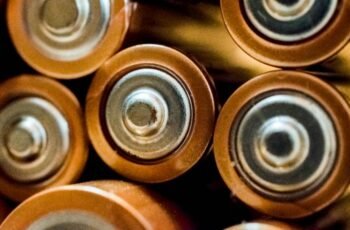The Tappovaly LiFePO4 kit pairs four Grade A cells for a compact, high-cycle power source with low resistance and steady output. It ships as raw cells—no BMS, case, or wiring—demanding thoughtful assembly, compression, and protection. Its promise of 8000+ cycles and cool operation appeals to DIY energy builders, yet the setup isn’t plug-and-play. How it balances performance, safety, and cost becomes clear once its features and trade-offs are unpacked.
Key Takeaways
- Uses Grade A LiFePO4 cells (≈896Wh each) with ≥160Wh/kg energy density and ≤0.25 mΩ internal resistance for efficient, safe performance.
- Delivers 8000+ cycles and up to 10-year service life; low self-discharge (≤3%/month) supports long-term reliability.
- Ships as bare cells with busbars and nuts; requires an external BMS, wiring, enclosure, and proper compression.
- Suitable for 12V systems and scalable to 24V/48V banks for solar, RV, marine, golf carts, and off-grid applications.
- Weighs about 49.8 lbs; no integrated protections or smart monitoring, and limited long-term user feedback available.
96WH Lifepo4 Kit Overview
Why consider a WH LiFePO4 kit built around Tappovaly’s 3.2V 280Ah cells? It consolidates four Grade A cells into a straightforward building block for 12V-class systems, bundling busbars and nuts to simplify assembly. The nominal energy per cell is 896Wh, enabling scalable watt-hour planning for solar, RV, marine, golf cart, and off-grid applications.
The chemistry’s inherent stability, including low thermal runaway risk, suits users prioritizing safety with high cycle longevity. With self-discharge at ≤3% per month and internal resistance ≤0.25 mΩ, the kit supports efficient storage and delivery. Dimensions and weight inform enclosure design and portability considerations. Warranty and support reinforce buyer confidence.
Detailed features
How does Tappovaly’s 3.2V 280Ah LiFePO4 set distinguish itself? It combines four Grade A cells with matching busbars and nuts, delivering a nominal 896Wh per cell at 3.2V and ≥160Wh/kg energy density. Each cell targets ≤0.25 mΩ internal resistance, ≤3% monthly self-discharge, and 8000+ cycles for long service life.
Thermal stability stems from lithium iron phosphate chemistry: high decomposition temperature, reduced heat generation, and lower risk of runaway. Dimensions measure 6.85 x 2.75 x 8.03 inches per cell, with a 49.8-pound package. The kit supports solar, RV, marine, golf cart, off-grid, and new-energy ship integrations. Warranty details are provided.
Pros and Cons
This section outlines the key pros and cons of the Tappovaly 3.2V 280Ah LiFePO4 battery set. It weighs the high cycle life, safety profile, and included hardware against considerations like weight, limited user ratings, and niche sizing. Readers can use these points to gauge fit for solar, RV, marine, and off-grid applications.
Pros
Among its strongest advantages, the Tappovaly 3.2V 280Ah LiFePo4 set offers exceptional cycle life (8000+ cycles) and a long service lifespan of up to 10 years, making it cost-effective for long-term off‑grid and mobile power. It delivers high usable energy (896Wh per cell) with low self‑discharge (≤3%/month), maintaining readiness for RVs, boats, and solar storage. Extremely low internal resistance (≤0.25 mΩ) supports efficient charge/discharge with reduced heat. LiFePO4 chemistry enhances safety via high thermal decomposition temperature and stability. Included busbars and nuts simplify assembly, while Grade A cells promote consistent performance and energy density (≥160Wh/kg).
| Benefit | Spec | Impact |
|---|---|---|
| Efficiency | ≤0.25 mΩ | Lower losses |
| Longevity | 8000+ cycles | Lower TCO |
| Safety | LiFePO4 | Thermal stability |
| Capacity | 280Ah | Deep reserves |
| Readiness | ≤3%/month | Infrequent charging |
Cons
Strengths aside, several drawbacks merit attention. The kit arrives as bare cells with busbars and nuts, requiring a separate BMS, enclosure, cabling, and proper compression—raising total cost and complexity. At nearly 50 pounds for the set, handling and mounting can be cumbersome. No integrated protections or smart monitoring are included. Shipping and availability appear recent, with minimal buyer feedback and limited real-world longevity reports. Cycle life claims (8000+) are attractive but depend on conservative charge/discharge and temperature control. Nominal energy density is competitive, yet 3.2V cells demand series configuration for 12V/24V systems, increasing assembly steps and potential wiring errors.
Concluding thoughts
Ultimately, Tappovaly’s 3.2V 280Ah LiFePo4 cells present a compelling blend of safety, longevity, and usable energy for solar, RV, marine, and off‑grid builds.
Their Grade A chemistry, low internal resistance, and ≥160Wh/kg density support efficient, cool operation with 8000+ cycles and a decade‑scale service life.
The included busbars and nuts simplify pack assembly, while the 896Wh per cell rating scales cleanly for 12V, 24V, or 48V banks.
Weight and availability may temper impulse buys, yet the package, warranty links, and responsive pricing stance strengthen value.
For builders prioritizing stable, deep‑cycle storage, these cells merit short‑list consideration.
Conclusion
In the end, this kit is a box of raw ore—four bright ingots awaiting a smith. Its promise gleams: long cycles, cool temper, dense strength. Yet it arrives unscabbarded, demanding a hilt of BMS, a sheath of enclosure, the forge of careful compression. For builders, it is a ladder without rails: climb yields vistas of 12/24/48V freedom; misstep invites risk. Chosen wisely, it becomes a steady lantern—lean, durable, and scaled to the traveler’s path.



